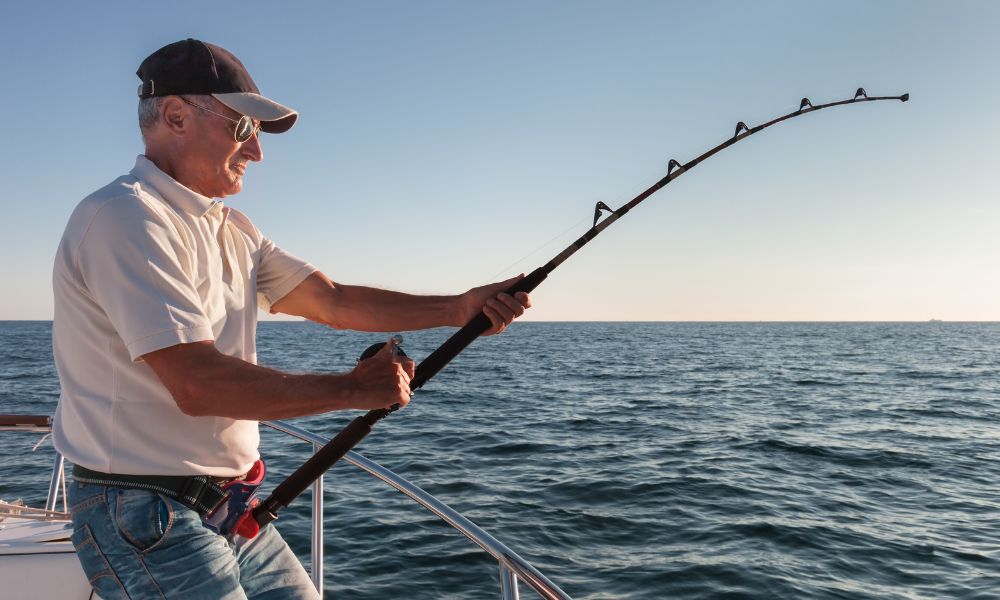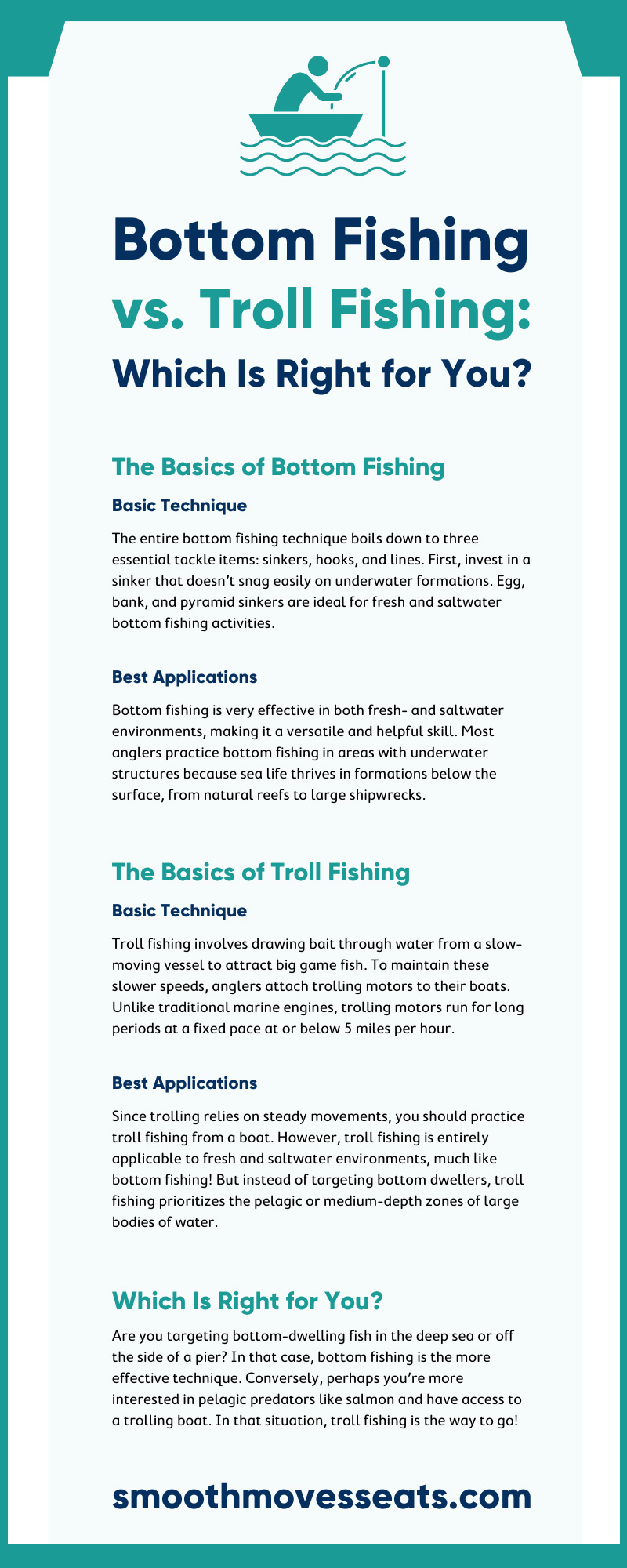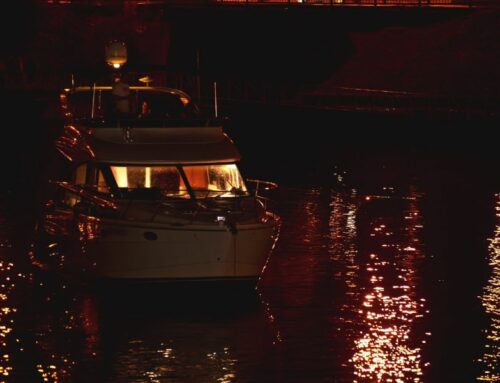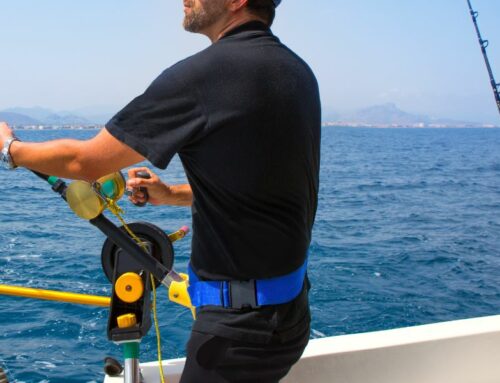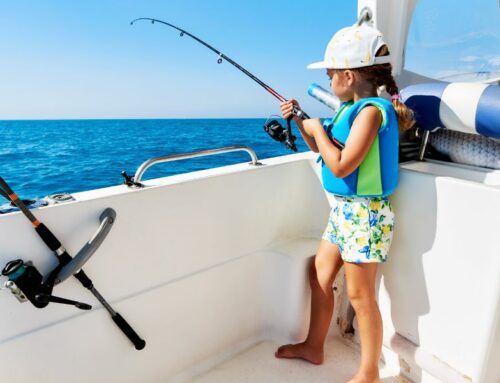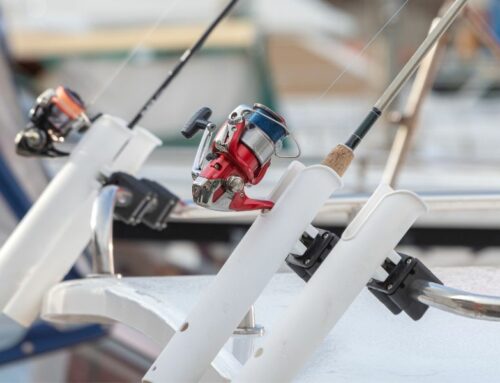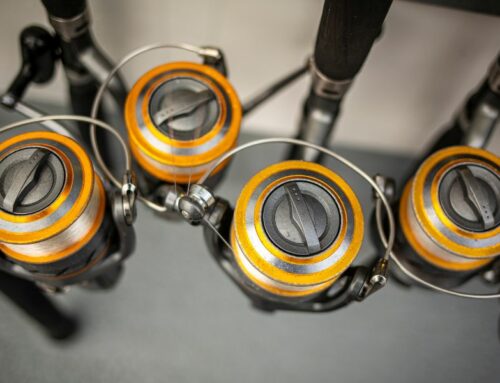Summer is right around the corner—are you ready for an active and successful fishing season? Before you tow your boat down to the local docks for a day filled with casting and reeling, understanding effective angling techniques is essential. Read on to learn more about bottom fishing and troll fishing to determine which method is right for you.
The Basics of Bottom Fishing
Put simply, bottom fishing is a popular angling technique that utilizes a weighted lure or hook to target fish at the bottom of the water column. In essence, bottom fishing finds large pockets of active fish in otherwise inactive bodies of water. Read on to learn more about the basic techniques and best bottom fishing applications so you can master this ever-popular method!
Basic Technique
The entire bottom fishing technique boils down to three essential tackle items: sinkers, hooks, and lines. First, invest in a sinker that doesn’t snag easily on underwater formations. Egg, bank, and pyramid sinkers are ideal for fresh and saltwater bottom fishing activities. As for fishing lines, we highly recommend a braided or fluorocarbon line for superior stealth, speed, and strength. Conversely, avoid mono lines, as these products are exceptionally buoyant. Finally, purchase heavy circle hooks to ensure a weighted and sturdy rig.
With the proper sinker, hook, and line, you are now ready to start bottom fishing effectively! But before you cast your line, ensure you have a proper bottom fishing rig. We recommend the sliding sinker, spreader, and three-way rigs, especially when fishing for larger species. Finally, anchor your vessel and drop your rig till it approaches the seafloor. Then, simply wait for the bottom-dwelling fish to come to you!
Best Applications
Bottom fishing is very effective in both fresh- and saltwater environments, making it a versatile and helpful skill. Most anglers practice bottom fishing in areas with underwater structures because sea life thrives in formations below the surface, from natural reefs to large shipwrecks. These underwater locations boast impressive biodiversity and large quantities of hungry fish.
Therefore, the best applications for bottom fishing include shore, nearshore, and off-shore fishing activities. Specifically, practice bottom fishing around bridge pilings, reefs, piers, rigs, seafloor drop-offs, and rocky formations. These areas are the most likely to result in large, bountiful catches. And since bottom fishing primarily occurs at the seafloor, expect many bottom-dwelling fish and predators on the line. In fact, consider using this technique to increase your chances of snagging panfish, grouper, bluegill, perch, carp, bass, and more!
The Basics of Troll Fishing
Similar to bottom fishing, trolling is an incredibly popular fishing technique anglers everywhere use. In fact, it’s such an effective method that commercial fishing companies use massive troll fishing rigs to catch large quantities of fish. However, trolling is also supremely enjoyable as a recreational activity by yourself or with others. Read on to learn about the basics of troll fishing, ideal applications, and more!
Basic Technique
Troll fishing involves drawing bait through water from a slow-moving vessel to attract big game fish. To maintain these slower speeds, anglers attach trolling motors to their boats. Unlike traditional marine engines, trolling motors run for long periods at a fixed pace at or below 5 miles per hour. On deep-ocean trolling boats, anglers typically place fishing rods in rod holders affixed to the stern side of the vessel to reduce labor and stress. Additionally, special downriggers, outriggers, boards, spreads, and paravanes can separate multiple lines. However, many solo anglers simply hold one fishing rod as they troll through the water, especially in freshwater environments.
The actual act of trolling is quite simple—the angler casts their line and maintains a 20–150-foot distance between the hook and the boat. While trolling, the angler can jerk the fishing rod sporadically to attract more action. However, the trolling motion itself is often enough to spark interest in your bait. We highly recommend maintaining a speed of 1.5–2.5 miles per hour for the best results. Additionally, ensure you pack troll-friendly tackle on your boat before departing for a fishing excursion. Crankbaits, natural baits, and shad-style minnows are ideal bait options for troll fishing. Furthermore, consider purchasing shiny baits, lures, and hooks to attract more fish to your movements.
Best Applications
Since trolling relies on steady movements, you should practice troll fishing from a boat. However, troll fishing is entirely applicable to fresh and saltwater environments, much like bottom fishing! But instead of targeting bottom dwellers, troll fishing prioritizes the pelagic or medium-depth zones of large bodies of water. Unlike fish found around underwater formations, pelagic predators are mobile and hunt active prey. Utilize troll fishing techniques to catch salmon, mackerel, tuna, and more!
Which Is Right for You?
Between these two fishing techniques, which is best for you? After learning more about both, it’s clear that each method features unique benefits and advantages while fishing. Ultimately, the ideal option for you is one that fits your application. Are you targeting bottom-dwelling fish in the deep sea or off the side of a pier? In that case, bottom fishing is the more effective technique. Conversely, perhaps you’re more interested in pelagic predators like salmon and have access to a trolling boat. In that situation, troll fishing is the way to go!
Most importantly, both fishing techniques are applicable while on a boat, meaning you can pack equipment for bottom and troll fishing on your next boating excursion. Simply prepare and tackle the unique rigs before leaving the dock and switch between fishing techniques throughout the day. Utilizing each angling skill will maximize your haul and enhance the overall fishing experience.
Whether you prefer bottom fishing or troll fishing, understanding the basics of both can help you determine which is right for you. However, without proper support, it’s harder to experience a truly enjoyable fishing trip. That’s why our team at Smooth Moves proudly carries a high-quality hydraulic boat pedestal to enhance the suspension of your boat’s existing seating. Browse our selection and improve your onboard comfort today!



